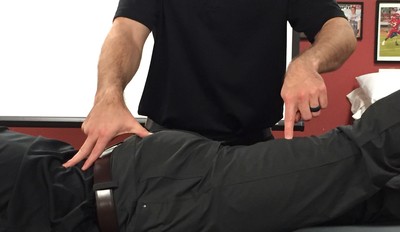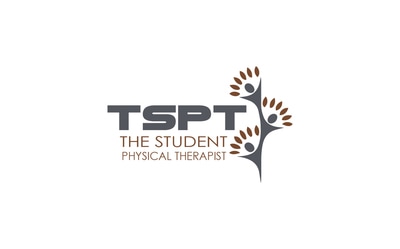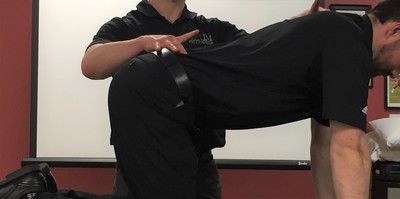- Home
- About Us
- TSPT Academy
- Online Courses
-
Resources
- Newsletter
- Business Minded Sports Physio Podcast
- Day in the Life of a Sports PT
- Residency Corner
-
Special Tests
>
-
Cervical Spine
>
- Alar Ligament Test
- Bakody's Sign
- Cervical Distraction Test
- Cervical Rotation Lateral Flexion Test
- Craniocervical Flexion Test (CCFT)
- Deep Neck Flexor Endurance Test
- Posterior-Anterior Segmental Mobility
- Segmental Mobility
- Sharp-Purser Test
- Spurling's Maneuver
- Transverse Ligament Test
- ULNT - Median
- ULNT - Radial
- ULNT - Ulnar
- Vertebral Artery Test
- Thoracic Spine >
-
Lumbar Spine/Sacroiliac Joint
>
- Active Sit-Up Test
- Alternate Gillet Test
- Crossed Straight Leg Raise Test
- Extensor Endurance Test
- FABER Test
- Fortin's Sign
- Gaenslen Test
- Gillet Test
- Gower's Sign
- Lumbar Quadrant Test
- POSH Test
- Posteroanterior Mobility
- Prone Knee Bend Test
- Prone Instability Test
- Resisted Abduction Test
- Sacral Clearing Test
- Seated Forward Flexion Test
- SIJ Compression/Distraction Test
- Slump Test
- Sphinx Test
- Spine Rotators & Multifidus Test
- Squish Test
- Standing Forward Flexion Test
- Straight Leg Raise Test
- Supine to Long Sit Test
-
Shoulder
>
- Active Compression Test
- Anterior Apprehension
- Biceps Load Test II
- Drop Arm Sign
- External Rotation Lag Sign
- Hawkins-Kennedy Impingement Sign
- Horizontal Adduction Test
- Internal Rotation Lag Sign
- Jobe Test
- Ludington's Test
- Neer Test
- Painful Arc Sign
- Pronated Load Test
- Resisted Supination External Rotation Test
- Speed's Test
- Posterior Apprehension
- Sulcus Sign
- Thoracic Outlet Tests >
- Yergason's Test
- Elbow >
- Wrist/Hand >
- Hip >
- Knee >
- Foot/Ankle >
-
Cervical Spine
>
- I want Financial Freedom
- I want Professional Growth
- I want Clinical Mastery
Hip mobility is an area that often needs to be restored. Check out this complimentary Insider Access video for unique ways to improve hip flexion mobility. |
|
Craig's Test
Purpose: To determine the anteversion of the femur.
Test Position: Prone.
Performing the Test: The tested limb's knee is placed in 90 degrees of flexion. The examiner rotates the hip medially and laterally, while palpating the greater trochanter area, until the outward most point is found in the lateral aspect of the hip (the greater trochanter is parallel to the table at this point). In individuals with severely limited hip motion, this position may not be achieved. The examiner then measures the angle of the hip with a goniometer to determine the amount of anteversion, using the long axis of the tibia. Normal hip anteversion is 8-15 degrees (8-15 degrees of medial rotation is normal).
Diagnostic Accuracy: Unknown.
Importance of Test: According to Neumann, the head of the femur projects medially and anteriorly to make contact with the acetabulum, thus placing the femoral neck at an angle compared to the table when prone. With medial rotation of a hip, the point at which the greater trochanter feels most superficial at the lateral hip occurs at the same time the femoral neck is parallel to the table. Due to the tibia being attached to the femur, the tibia follows during rotation and can be used to get a measurement with a goniometer. Individuals with abnormal anteversion (or retroversion) angles of the femur are more susceptible to femoral acetabular impingement, and, thus, labral damage. The position of the femoral head also affects the individual's gait. Individuals with hip dysplasia have an abnormally high amount of anteversion and must medially rotate the hips in order to improve the moment arms of the hip abductors for gait. The appearance results with a gait pattern with the toes pointed inward (some individuals will try to compensate for the in-toeing by laterally rotating the knee).
Note: these tests should only be performed by properly trained health care practioners
Test Position: Prone.
Performing the Test: The tested limb's knee is placed in 90 degrees of flexion. The examiner rotates the hip medially and laterally, while palpating the greater trochanter area, until the outward most point is found in the lateral aspect of the hip (the greater trochanter is parallel to the table at this point). In individuals with severely limited hip motion, this position may not be achieved. The examiner then measures the angle of the hip with a goniometer to determine the amount of anteversion, using the long axis of the tibia. Normal hip anteversion is 8-15 degrees (8-15 degrees of medial rotation is normal).
Diagnostic Accuracy: Unknown.
Importance of Test: According to Neumann, the head of the femur projects medially and anteriorly to make contact with the acetabulum, thus placing the femoral neck at an angle compared to the table when prone. With medial rotation of a hip, the point at which the greater trochanter feels most superficial at the lateral hip occurs at the same time the femoral neck is parallel to the table. Due to the tibia being attached to the femur, the tibia follows during rotation and can be used to get a measurement with a goniometer. Individuals with abnormal anteversion (or retroversion) angles of the femur are more susceptible to femoral acetabular impingement, and, thus, labral damage. The position of the femoral head also affects the individual's gait. Individuals with hip dysplasia have an abnormally high amount of anteversion and must medially rotate the hips in order to improve the moment arms of the hip abductors for gait. The appearance results with a gait pattern with the toes pointed inward (some individuals will try to compensate for the in-toeing by laterally rotating the knee).
Note: these tests should only be performed by properly trained health care practioners
References:
Neumann, Donald. Kinesiology of the Musculoskeletal System: Foundations for Rehabilitation. 2nd edition. St. Louis, MO: Mosby Elsevier, 2010. 470-471. Print.
Neumann, Donald. Kinesiology of the Musculoskeletal System: Foundations for Rehabilitation. 2nd edition. St. Louis, MO: Mosby Elsevier, 2010. 470-471. Print.
Copyright © The Student Physical Therapist LLC 2023




